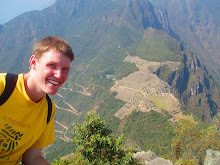



From here, most people walk through the city, with palaces, tombs, houses, and an amphitheater on either side of Wadi Musa, the dried riverbed running through here.


That morning I took the hike up to the High Place of Sacrifice for awesome views of the surrounding area.


Continuing along the Wadi takes you to the start of the hike to the Monastery, a massive building used for religious meetings (though not Christian ones, obviously). I liked the building and the area at the top so much I did it twice, though it is a hard 45 minute hike. There are rocks to climb for spectacular views of the building and about 400m past the monastery is a cliff face looking out to mountains and further out, Saudi Arabia.



And here are pictures from various trails I explored along the way, including the Wadi Mudhlim alternative entrance to Petra, where there are literally no other people anywhere (top left) and hiking up to Al-Khubtha, a mountain with views over looking the ruins and even the treasury (top right, bottom left):






As a side note, I was surprised to find more little desert animals running around here than I ever saw in the rainforests I went to. This desert, for all its barren appearance is quite alive, even apart from the poor donkeys and camels that some tourists ride on. All in all, this place was absolutely incredible.
-------------------------------------------------------------------------------------------------
Details:
Since I had some flight trouble out of Beijing and ended up getting to Jordan three days later than I intended, I was left for little options in terms of transportation because I already had a plane booked out of Jordan to Turkey. I needed to get directly from the Amman airport to Petra if I wanted to make anything of my time there, but there is no way to do this cheaply. No bus, train, shared car, minibus, anything. There are airport taxis (which charge double the price of normal taxis in Jordan) and rental cars. One thing to maybe try is to go to the Departures area and try to get the normal taxis as they let out passengers, I've heard the one-way cost to Petra is $49/35JD if you are good at bartering. The airport taxis charge $98/70JD. Rental cars are $49/35JD per day at the Avis stand in the airport. A tank of gas is about $28/20JD and it is around a third of a tank from the airport to Petra and back. My cheapest option was definitely the rental car, with the bonus of more freedom, because I only had three days. The road to Petra is really good: flat, straight, and easy to follow it to Petra. The Desert Highway, as it is called (or Highway 15) passes right by the airport and follow it towards Aqaba for about 1.5 hours before turning off (look for signs saying Petra) and just keep following them until you arrive in Wadi Musa.

No comments:
Post a Comment